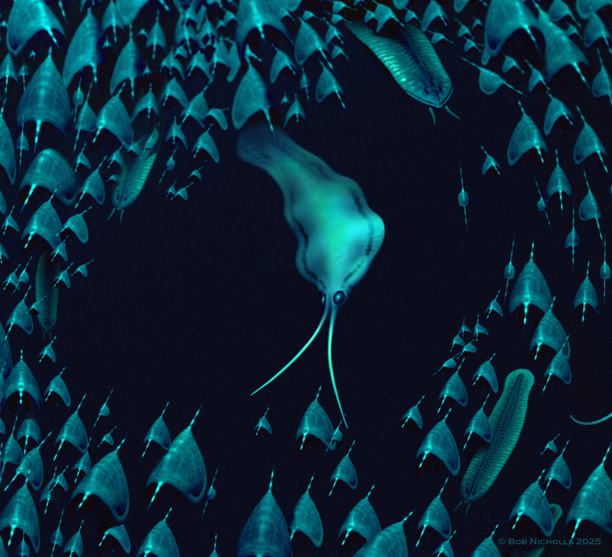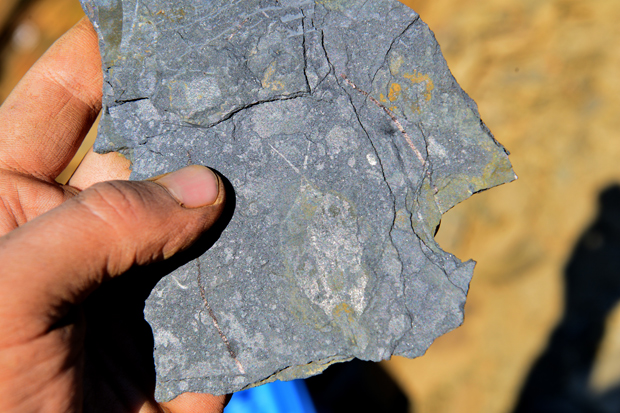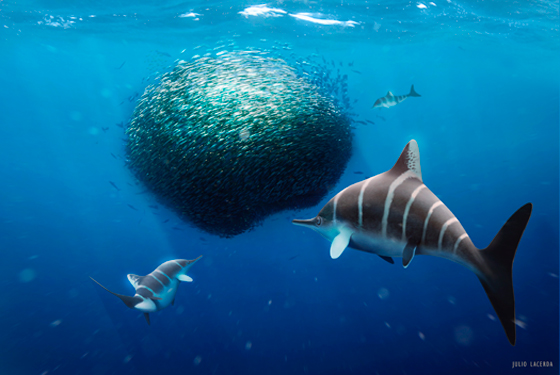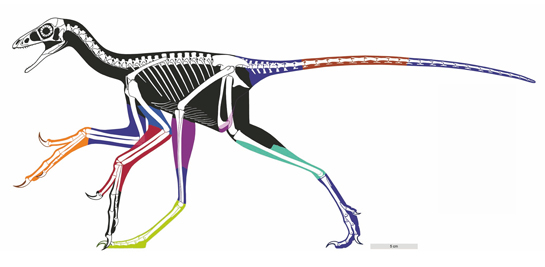Stunning fossils of Cambrian nectocaridids solves a half-a-billion-year-old evolutionary puzzle. Fossil material excavated from the Sirius Passet site in North Greenland has enabled palaeontologists to identify these ancient marine invertebrates as early descendants of chaetognaths (arrow worms). It had been proposed that these animals were a type of cephalopod. Cephalopods are marine molluscs with tentacles and a prominent head. Living cephalopods include cuttlefish, octopi and squid. The extinct ammonites and belemnites were cephalopods.
This significant discovery rewrites part of the story of the Cambrian Explosion. It shows arrow worms descended from complex predators, not simple marine organisms.

Life reconstruction of Nektognathus, swimming in the Cambrian Sea. It is depicted as a nektonic predator. Picture credit: Bob Nicholls.
Picture credit: Bob Nicholls
The illustration of Cambrian life (above) was created by acclaimed palaeo-reconstruction artist Bob Nicholls. Bob has recently been collaborating with Everything Dinosaur in the production of museum quality prehistoric animal models – Everything Dinosaur Evolution.
To learn more about these remarkable, scientifically accurate figures: Everything Dinosaur Evolution Figures.
Studying Cambrian Nectocaridids
The research team included palaeontologists from the University of Bristol, the University of Copenhagen, and the Korean Polar Research Institute. Their work builds on nine years of expeditions to Sirius Passet, a site famous for exceptional soft-tissue fossil preservation from 518 million years ago (Stage 3 of the Cambrian).
Co-author of the study, Dr Jakob Vinther, Associate Professor in Macroevolution at the University of Bristol commented:
“Sirius Passet is a treasure trove of fossils from the Cambrian Explosion. We not only find delicate soft-bodied fossils but also their digestive systems, musculature and sometimes even their nervous system.”
Research first published in 2009 examining fossils from the famous Burgess Shale deposits of British Columbia (Canada), linked nectocaridids to cephalopods. However, some invertebrate palaeontologists remained sceptical.
Dr Vinther explained:
“Around 15 years ago a research paper, based on fossils from the famous Burgess Shale, claimed nectocaridids were cephalopods. It never really made sense to me, as the hypothesis would upend everything we otherwise know about cephalopods and their anatomy didn’t closely match cephalopods when you looked carefully.”
Field team members became excited as they found twenty-five new specimens of Cambrian nectocaridids in the Sirius Passet deposits. These are the first nectocaridids unearthed from the Sirius Passet locality. Evidence of nervous systems were preserved in some specimens.

A fossil specimen of Nektognathus discovered at Sirius Passet (northern Greenland). Picture credit: University of Bristol.
Picture credit: University of Bristol
Identifying the Ventral Ganglion
The team discovered nectocaridids with parts of their nervous system preserved as paired mineralised structures. This new evidence helped to confirm the phylogeny of these ancient animals. Arrow worm fossils with preserved ventral ganglia – a unique nerve structure seen in modern chaetognaths (arrow worms) were also found.
Co-author of the paper, Dr Tae-Yoon Park from the Korean Polar Institute stated:
“These fossils all preserve a unique feature, distinct for arrow worms, called the ventral ganglion.”
The discovery of this structure confirms the evolutionary link between nectocaridids and arrow worms.
Picture credit: Tae-Yoon Park
The authors of the study have erected a new nectocaridid taxon Nektognathus evasmithae. The species name honours Professor Eva Smith, the first female professor of law in Denmark and renowned human rights advocate. Dr Vinther commented that N. evasmithae was a smart and stealthy fighter, just like the Danish advocate.
Dr Park added:
“We now had a smoking gun to resolve the nectocaridid controversy. Nectocaridids share a number of features with some of the other fossils that also belong to the arrow worm stem lineage. Many of these features are superficially squid-like and reflect simple adaptations to an active swimming mode of life in invertebrates, just like whales and ancient marine reptiles end up looking like fish when they evolve such a mode of life.”

The holotype specimen of Nektognathus from Sirius Passet imaged with Electron Probe microanalysis for its carbon content. Picture credit: Mirinae Lee and Chankun Park.
Picture credit: Mirinae Lee and Chankun Park
Cambrian Nectocaridids – Dynamic, Nektonic, Agile Predators
This surprising discovery means the rather simple marine arrow worms had ancestors with much more complex anatomies and a predatory role higher up in the food chain. Cambrian nectocaridids had camera-type eyes, long antennae, and streamlined bodies for active hunting. In contrast, extant arrow worms have eyes that are sensitive to light but are not thought to have effective vision. The researchers conclude that the ancestors of today’s arrow worms were nektonic predators. They filled an ecological niche similar to living squid. Although, squids evolved much later. Preserved gut contents indicate that Nektognathus evasmithae fed on the swimming arthropod Isoxys.
Dr Vinther commented:
“We can therefore show how arrow worms used to occupy a role much higher in the food chain. Our fossils can be much bigger than a typical living arrow worm and combined with their swimming apparatus, eyes and long antennae, they must have been formidable and stealthy predators.”
Picture credit: Tae-Yoon Park
This study gives us a new view of Cambrian nectocaridids. Far from being early squids, they were fierce predators with an advanced anatomy. This study helps palaeontologists to better understand Cambrian marine ecosystems.
Everything Dinosaur acknowledges the assistance of a media release from the University of Bristol in the compilation of this article.
The scientific paper: “A fossilised ventral ganglion reveals a chaetognath affinity for Cambrian nectocaridids” by Jakob Vinther et al published in Science Advances.
The award-winning Everything Dinosaur website: Prehistoric Animal Models and Figures.






Leave A Comment